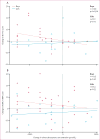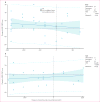Cognitive and motor performance in Congolese children with konzo during 4 years of follow-up: a longitudinal analysis
- PMID: 28807191
- PMCID: PMC5594926
- DOI: 10.1016/S2214-109X(17)30267-X
Cognitive and motor performance in Congolese children with konzo during 4 years of follow-up: a longitudinal analysis
Abstract
Background: Konzo is an irreversible upper-motor neuron disorder affecting children dependent on bitter cassava for food. The neurocognitive ability of children with konzo over time has yet to be fully documented.
Methods: We did a longitudinal study in a konzo outbreak zone continuously affected by konzo since 1990, in the district of Kahemba, southern Bandundu Province, Congo. We enrolled children with a record of neurological diagnosis of konzo in Kahemba town. For all study children with konzo enrolled in the final sample for the baseline assessment, a neurological exam was done by neurologists to confirm konzo diagnosis using the 1996 WHO criteria at 2 years and 4 years. In the initial baseline sample for each child with konzo, we attempted to get consent from a comparison child without konzo (1996 WHO criteria) within 2 years of age, from a neighbouring household who met inclusion criteria. The neuropsychological assessments were the Kaufman Assessment Battery for Children, second edition (KABC-II), and the Bruininks-Oseretsky Test of Motor Proficiency, second edition (BOT-2).
Findings: Data collection occurred between Oct 12, 2011, and Aug 14, 2015, in the town of Kahemba. 123 children from the Congo with konzo and 87 presumably healthy children without konzo from neighbouring households were enrolled. The planned assessments were completed by 76 children with konzo and 82 children without konzo at 2-year follow-up, and by 55 children with konzo and 33 children without konzo at 4-year follow-up. Boys with konzo did worse than those without konzo on the KABC-II Learning (p=0·0424) and on the Mental Processing Index (MPI; p=0·0111) assessments at 2-year follow-up, but girls did not. These differences observed in boys might have been caused by stunting. At 4-year follow-up, the difference in KABC-II MPI score between boys or girls with or without konzo was not significant. Both boys and girls with konzo had lower scores on BOT-2 than children without konzo at both follow-up times (p<0·0001). These differences were not attenuated when controlling for physical growth. Boys with and without konzo declined on BOT-2 fine motor proficiency at 2-year follow-up (boys with konzo p=0·0076; boys without konzo p=0·0224) and KABC-II MPI performance at 2-year follow-up and 4-year follow-up (2 years: boys with konzo p<0·0001, boys without konzo p=0·0213; 4 years: boys with konzo p=0·0256, boys without konzo p=0·10), but that was not the case for the girls with scores remaining stable regardless of konzo status. For boys, increases in urinary thiocyanate concentration was significantly associated with reductions in BOT-2 motor proficiency (p=0·0321), but was not significantly associated in girls and urinary thiocyanate concentration was not associated with KABC-II MPI score for either boys or girls.
Interpretation: Motor and cognitive performance continues to be significantly impaired in boys with konzo at 2-year follow-up compared with boys without konzo. Because these impairments are associated in part with exposure to poorly processed cassava as measured by urinary thiocyanate, interventions are urgently needed to ensure improved processing of cassava to detoxify this food source.
Funding: US National Institutes of Health.
Copyright © 2017 The Author(s). Published by Elsevier Ltd. This is an Open Access article under the CC BY-NC-ND 4.0 license. Published by Elsevier Ltd.. All rights reserved.
Conflict of interest statement
We declare no competing interests.
Figures



Comment in
-
Cassava, konzo, and neurotoxicity.Lancet Glob Health. 2017 Sep;5(9):e853-e854. doi: 10.1016/S2214-109X(17)30306-6. Lancet Glob Health. 2017. PMID: 28807173 Free PMC article. No abstract available.
Similar articles
-
Konzo: a distinct neurological disease associated with food (cassava) cyanogenic poisoning.Brain Res Bull. 2019 Feb;145:87-91. doi: 10.1016/j.brainresbull.2018.07.001. Epub 2018 Jul 5. Brain Res Bull. 2019. PMID: 29981837 Free PMC article. Review.
-
Neuropsychological effects of konzo: a neuromotor disease associated with poorly processed cassava.Pediatrics. 2013 Apr;131(4):e1231-9. doi: 10.1542/peds.2012-3011. Epub 2013 Mar 25. Pediatrics. 2013. PMID: 23530166 Free PMC article.
-
Lower serum levels of selenium, copper, and zinc are related to neuromotor impairments in children with konzo.J Neurol Sci. 2015 Feb 15;349(1-2):149-53. doi: 10.1016/j.jns.2015.01.007. Epub 2015 Jan 10. J Neurol Sci. 2015. PMID: 25592410 Free PMC article.
-
Serum 8,12-iso-iPF2α-VI isoprostane marker of oxidative damage and cognition deficits in children with konzo.PLoS One. 2014 Sep 15;9(9):e107191. doi: 10.1371/journal.pone.0107191. eCollection 2014. PLoS One. 2014. PMID: 25222616 Free PMC article.
-
Konzo and continuing cyanide intoxication from cassava in Mozambique.Food Chem Toxicol. 2011 Mar;49(3):631-5. doi: 10.1016/j.fct.2010.06.056. Epub 2010 Jul 21. Food Chem Toxicol. 2011. PMID: 20654676 Review.
Cited by
-
Konzo: a distinct neurological disease associated with food (cassava) cyanogenic poisoning.Brain Res Bull. 2019 Feb;145:87-91. doi: 10.1016/j.brainresbull.2018.07.001. Epub 2018 Jul 5. Brain Res Bull. 2019. PMID: 29981837 Free PMC article. Review.
-
Motor control and cognition deficits associated with protein carbamoylation in food (cassava) cyanogenic poisoning: Neurodegeneration and genomic perspectives.Food Chem Toxicol. 2021 Feb;148:111917. doi: 10.1016/j.fct.2020.111917. Epub 2020 Dec 6. Food Chem Toxicol. 2021. PMID: 33296712 Free PMC article.
-
Preclinical and clinical research on the toxic and neurological effects of cassava (Manihot esculenta Crantz) consumption.Metab Brain Dis. 2020 Jan;35(1):65-74. doi: 10.1007/s11011-019-00522-0. Epub 2019 Dec 4. Metab Brain Dis. 2020. PMID: 31802307 Review.
-
Children's cognitive impairment associated with cassava cyanide in Democratic Republic of the Congo: Burden of disease.PLOS Glob Public Health. 2024 Jan 16;4(1):e0002761. doi: 10.1371/journal.pgph.0002761. eCollection 2024. PLOS Glob Public Health. 2024. PMID: 38227557 Free PMC article.
-
Cassava, konzo, and neurotoxicity.Lancet Glob Health. 2017 Sep;5(9):e853-e854. doi: 10.1016/S2214-109X(17)30306-6. Lancet Glob Health. 2017. PMID: 28807173 Free PMC article. No abstract available.
References
-
- WHO. Konzo, a distinct type of upper motoneuron disease. Wkly Epidemiol Rec. 1996;71:225–32. - PubMed
-
- Tylleskar T, Tshala-Katumbay D, Konzo . A permanent, non-progressive, motor neuron disease. In: Jagjit Chopra., editor. Neurology in Tropics. 2. India: Elsevier; 2015. pp. 377–86.
-
- Tshala-Katumbay D, Eeg-Olofsson KE, Tylleskar T, Kazadi-Kayembe T. Impairments, disabilities and handicap pattern in konzo—a non-progressive spastic para/tetraparesis of acute onset. Disabil Rehabil. 2001;23:731–36. - PubMed
-
- Cliff J, Nicala D. Long-term follow-up of konzo patients. Trans R Soc Trop Med Hyg. 1997;91:447–49. - PubMed
Publication types
MeSH terms
Grants and funding
LinkOut - more resources
Full Text Sources
Other Literature Sources
Medical
Miscellaneous

